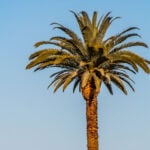ENCINITAS — A crowd of wide-eyed skywatchers donning protective eyewear gathered on April 8 at the Encinitas Public Library to glimpse a partial solar eclipse, although Southern California was far from the “path of totality” that saw the sun completely blocked out in other parts of the country.
The San Diego State University Astronomy Department hosted a public eclipse viewing event in Encinitas, attracting spectators of all ages eager to witness the rare celestial event.
The library offered free eclipse glasses but quickly ran out of stock. However, attendees like Solana Beach resident Anita Flagg and Fausto Morales of San Marcos were more than willing to share their eclipse glasses so others could observe the moon as it slowly concealed the sun.
Leucadia residents Toby Prager and Garit Imhoff came prepared with lawn chairs posted up outside of the library’s entrance. Imhoff, plucking the metal tines of an African mbira, softly chanted alongside Prager while both stared at the awe-inspiring astral showcase. 
Leucadia residents Toby Prager and Garit Imhoff sit in lawn chairs, softly playing music and singing, during the partial solar eclipse on April 8 in Encinitas. Photo by Jordan P. Ingram


Solana Beach firefighter John Morgan parked his fire truck on D Street and put on glasses to view the eclipse. New Jersey residents Eric and Giselle Velez also went to the library to enjoy the eclipse, which they said was an unexpected but exciting part of their spring vacation to Southern California.
While a gathering of people congregated near the library entrance, others found their way across the street to Encinitas Viewpoint Park, enjoying the stellar presentation while sitting atop blankets on the grassy hillside.
The total eclipse, in which the moon fully blocks the sun’s light for several minutes, made landfall Monday morning along Mexico’s Pacific coast. The eclipse path then crossed into Texas and 14 other U.S. states before exiting over Canada. Elsewhere in North America, including San Diego County, there was only a partial eclipse.
In areas of total eclipse, the moon shrouded the sun for up to 4 minutes and 28 seconds. The celestial event attracted millions of people to the cities and towns in its path.


Griffith Observatory in Los Angeles hosted a live online broadcast from Belton, Texas, from 10 a.m. to 1 p.m. Monday to give people a glimpse of the eclipse’s totality.
According to observatory officials, the height of the partial eclipse in Encinitas occurred around 11:15 a.m., with the moon covering 57% of the sun’s diameter and 49% of the sun’s area.
Eclipse observers were cautioned well in advance about the danger of staring directly at the sun to see the eclipse. For Monday’s eclipse and all future eclipses, health officials offered a series of tips:
Do not look directly at the sun;
Do not use sunglasses, binoculars, or telescopes;
Always supervise children using solar viewers;
Use a pinhole viewer to view the eclipse indirectly without looking at the sun, and
Wear eclipse glasses, or solar viewers, with certified solar filters and ensure lenses are in good condition.
The next partial eclipse visible in the San Diego area will be on Jan. 14, 2029. The U.S. won’t see another total eclipse until 2044.
City News Service contributed to this report.




